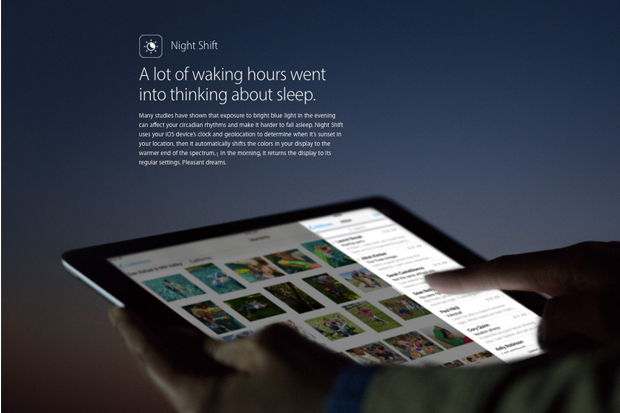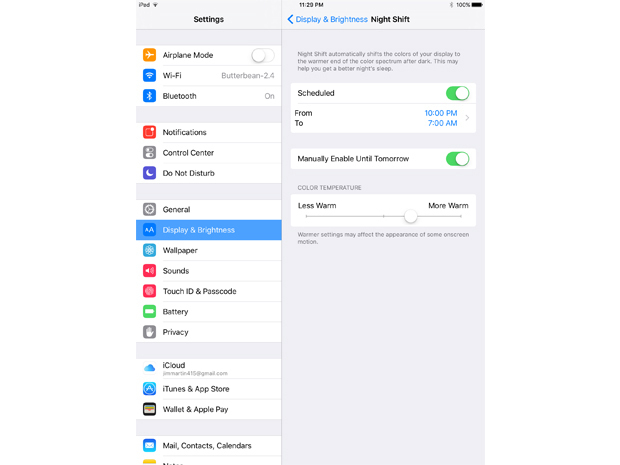
30 March 2016 – You know how it goes. You download the new iOS and then spend days reading about all the new bits and bobs it has. Over the weekend Jim Martin sent out a blurb on his CIO blog about the new “Night Shift” feature in Apple’s iOS 9.3 which aims to reduce the amount of sleep-destroying blue light mobile devices emit, though some critics question its effectiveness. If you recall, late last year Amazon debuted its similar “Blue Shade” feature.
What’s wrong with blue light? It can mess with the body’s melatonin levels, prevent people from nodding off at night, and create other sleep problems. A number of studies have been done on the subject of blue light and sleep, including an oft-cited report published by the Proceedings of the National Academy of Sciences in late 2014.
You know the drill. In the modern age of technology it is not uncommon to come home after a long day at work or school and blow off steam by reading an e-book or watching television. Lately, however, scientists have been cautioning against using light-emitting devices before bed. The light from our devices is “short-wavelength-enriched,” meaning it has a higher concentration of blue light than natural light—and those blue light affects levels of the sleep-inducing hormone melatonin more than any other wavelength.
Changes in sleep patterns can in turn shift the body’s natural clock, known as its circadian rhythm. Recent studies have shown that shifts in this clock can have devastating health effects because it controls not only our wakefulness but also individual clocks that dictate function in the body’s organs. In other words, stressors that affect our circadian clocks, such as blue-light exposure, can have much more serious consequences than originally thought.I wrote about last year
During the past year or so, the tech industry gave the green light to software updates that attempt to suppress or minimize the blue light that’s beamed from device screens. Of course, the tech companies’ motives aren’t entirely altruistic; device makers don’t benefit if their customers stop looking at mobile screens 60 to 90 minutes before bedtime, as doctors suggest.
I don’t know about you. I struggle with it. I’m actively trying to avoid blue light before lights out, but it’s a challenge for three reasons: my monkey mind and active life make me prone to sleeplessness; I tend to be busy all day, so I store articles in Instapaper all day long to read later — and “later” usually means 30 to 60 minutes before bedtime. I tried the switch from print to ebooks years ago, and I do have several digital magazine and newspaper subscriptions, but I find more and more I am returning to those stacks of magazines on my bedside table.
And quite frankly my Kindle doesn’t provide a satisfying reading experience, especially with magazines and newspapers.
But the size and weight of Apple’s iPad mini (the current generation) could make it an ideal bedtime ereader, now that Apple updated iOS with Night Shift. I still need to test it out. And note: the new generation iPad mini’s screen is easy to read in bright sunlight, which was an issue in previous generations.
The feature is easy to enable and adjust. You just swipe up from the bottom of your iOS device screen, and you’ll see a partially-shaded sun icon. When you tap it Night Shift gives your screen an amber cast.
Here is a screen shot of the Settings:
You can adjust Night Shift settings by going into Settings > Display & Brightness, where you get three controls that let you automatically schedule Night Shift to kick in; manually enable it “until tomorrow;” and adjust the color temperature from “Less Warm” to “More Warm” using a slider. As you drag the slider, you get a quick preview of how the screen will look. More Warm makes the screen deeply amber; Less Warm is more off-white.
And to be fair and balanced, Jim notes in his post:
At least one Night Shift critic believes the feature is little more than a placebo. “Night Shift, which turns down the amount of blue light produced by the display, won’t significantly affect the production of melatonin enough to influence the circadian rhythm and improve the user’s nighttime sleep cycle,” says Raymond Soneira, president of DisplayMate, a video diagnostics company.
Of course the trick might be to simply stick to reading stuff that isn’t about politics, work, or anything else that might push your buttons.
